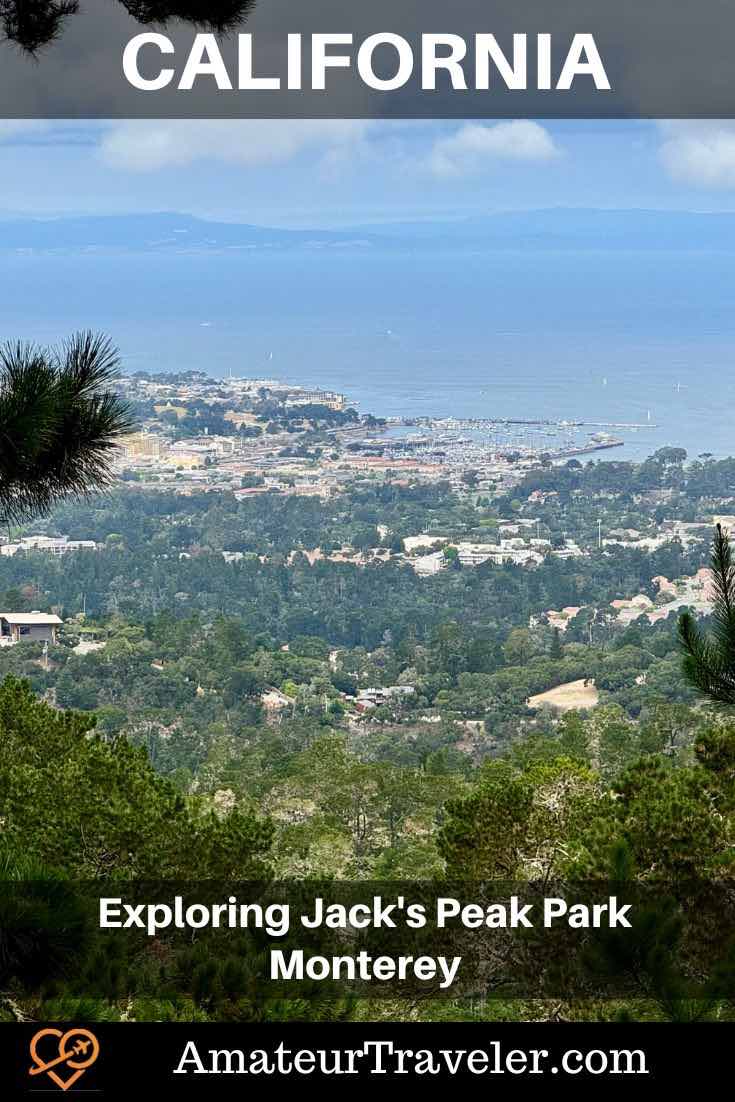Exploring Jack’s Peak Park – Monterey
categories: Central CoastJack’s Peak Park, located in the hills above Monterey, offers a serene escape into nature with its hiking trails and stunning views of the Monterey Bay area. This article provides a comprehensive guide to everything you need to know about Jack’s Peak Park.

View of Monterey from Skyline Trail, Jacks Peak Park
Location of Jack’s Peak Park
Jack’s Peak Park is on the Monterey Peninsula, just a short drive from the city of Monterey. It encompasses the highest point on the peninsula, offering panoramic views of the surrounding areas. The entrance road for Jack’s Peak is right by the Monterey Penninsula Airport.
Helpful Resources
Activities at Jack’s Peak Park
Jack’s Peak Park offers a variety of activities for visitors, including:
- Hiking: With several trails ranging from easy to moderately challenging, hikers can enjoy the park’s natural beauty.
- Picnicking: Numerous picnic areas are equipped with tables and grills, making them perfect for a family outing.
- Wildlife Viewing: The park is home to diverse wildlife, including deer, foxes, and a variety of bird species. It is part of the Central Coast Birding Trail so if you like birding, you should bring your binoculars.
- Photography: The scenic vistas and lush forests provide excellent opportunities for photography enthusiasts.
What Makes Jack’s Peak Park Special?
Jack’s Peak includes one of only 3 natural Monterey Pine forests left in the United States. It is a beautiful, peaceful spot. We most recently visited on one of those summer days when you had to drive around to find parking in Carmel, but oddly enough, Jack’s Peak wasn’t crowded. One thing that surprised me about the pine forest there was that it was not as fragrant as I would expect.
The park offers breathtaking views of Monterey Bay, Carmel Valley, and the Santa Lucia Mountains. You can get views of Monterey with little effort at all. You can see through the trees to the Monterey Views from the parking area closest to Jack’s Peak itself or walk just a short distance into Skyline Trail to get a less obstructed view. The views of Carmel Valley will take an easy one-mile hike to access. There are no views of Carmel, per se, as Carmel itself.
Best Hikes in Jack’s Peak Park
The park has 8.5 miles of hiking trails, some of which allow horses. Bikes are not allowed on any of the park’s trains.
Jack’s Peak Park features several excellent hiking trails. Here are some of the best:

Jack’s Peak and Skyline Trail
- length: .8 mile
- elevation gain: 121 feet
- trail type: loop
- difficulty: easy
- estimated time: 25 minutes
From the Jack’s Peak parking area, take the Skyline Trail (the rightmost trail as you look at the hill).

As in all state, regional, and national parks, you are encouraged to stay on the trail at Jack’s Peak… but doubly so at this park and many parks in the region because just off the trail is likely a great big patch of poison oak. So if you get the itch to create your own trail… you may really get the itch.

It is a short distance to a viewing area with great views of the Monterey Peninsula. The Skyline Trail has a self-guided nature hike. We had to make up our own guide to the trail, but since then, with the help of Sabrina from Monterey County Parks, I have been able to track down the official Jacks Peak Skyline Trail Brochure.
Continue along the trail until you get to what looks like an unmarked fire road heading down the hill. This is Coffeeberry Trail. It is supposed to be one of the best spots to find fossils in Jack’s Peak, which was once an island and an ancient seashore. We looked in the shale along the side of the trail but did not see anything we could prove was a fossil.
- Search for Great Tours HERE
- Book Your Accommodation HERE
- Buy Travel Insurance
- Get a Car Rental

Continuing along Skyline Trail, you will come to a sign explaining the fossils found in the park. The sign itself looks like it dates back to the Cenozoic period.

Nearby, there is also some exposed shale where you can look for yourself.

Continue along to the well-marked intersection of Skyline Trail and Jack’s Peak Trail. For this short loop, we will be coming back on Jack’s Peak Trail to the Parking lot… but before you do, I would encourage you to take a bit of a detour down the hill on the Skyline Trail. There are a series of steps going downhill from the intersection before the trail turns left.

Take the left turn, and before you get to a bench on the side of the path, you will have some of the best views of the Carmel Valley, Carmel River Beach, and Point Lobos State Preserve. I think it is worth the detour.
Skyline, Iris, Rhus Trail Loop
-
- length: 2.3 miles
- elevation gain: 498 feet
- trail type: loop
- difficulty: moderate
- estimated time: 1 hour 15 minutes
From Jack’s Peak parking area, take the Skyline Trail to the Iris Trail, left on the Rhus Trail, and right on the Iris Trail again to the parking lot. See the trail map link above.
5. Park Hours
| January & February | 8:00 am – 5:00 pm |
| March | 8:00 am – 6:00 pm |
| April | 8:00 am – 7:00 pm |
| May-August | 8:00 am – 7:00 pm |
| September | 8:00 am – 7:00 pm |
| October | 8:00 am – 6:30 pm |
| November & December | 8:00 am – 5:00 pm |
Directions to Jack’s Peak Park
From Monterey:
- Take CA-68 East towards Salinas.
- Turn right onto Olmsted Road.
- Turn right onto Jacks Peak Park Road and follow the signs to the park entrance.
From Salinas:
- Take CA-68 West towards Monterey.
- Turn left onto Olmsted Road.
- Turn right onto Jacks Peak Park Road and follow the signs to the park entrance.
Entrance Fees
The entrance fee for Jack’s Peak Park is $5 per vehicle. This fee helps maintain the park and its facilities.
History of Jack’s Peak Park
Early Inhabitants
Long before European settlers arrived, the land that is now Jack’s Peak Park was inhabited by the Rumsen Ohlone tribe. These indigenous people lived in harmony with the land, relying on its resources for food, shelter, and cultural practices.
Spanish Exploration and Land Grants
In the late 18th century, Spanish explorers arrived in California, and the land that includes Jack’s Peak was part of the Spanish land grants. The area was later included in the Rancho Aguajito land grant, awarded to early settlers during the Mexican period in California’s history.
Development
In the 19th and early 20th centuries, the land was used primarily for cattle grazing and agriculture. It wasn’t until the mid-20th century that efforts to preserve the area’s natural beauty began to take shape. The park is named after Scottish immigrant David Jack, who acquired part of the land for what is now the park when former Carmel Mission lands went up for auction in 1859.
Who Was David Jack?
David Jack, often referred to as “David Jacks,” was born in 1822 in Crieff, Perthshire, Scotland. He came to California during the Gold Rush era, initially seeking his fortune in mining. He eventually settled in Monterey, California, and became one of the largest landowners in Monterey County through various business ventures and sometimes controversial land deals. Jack was also instrumental in introducing and popularizing a type of cheese that became known as “Monterey Jack.”
Preservation
In 1964, Talcott and Margaret Pardee Bates purchased the first 55 acres of the park, which they later sold to the Nature Conservancy.
Establishment of the Park
Jack’s Peak Park was officially established in 1977, thanks to the combined efforts of local conservationists, the county government, and community members who recognized the importance of preserving this natural area for public enjoyment and ecological conservation. The park was created to protect the unique ecosystems and provide residents and visitors with a recreational space.
Ongoing Conservation Efforts
Since its establishment, the Monterey County Parks Department has managed Jack’s Peak Park. The park has seen various improvements over the years, including the development of hiking trails, picnic areas, and interpretive programs to educate visitors about the park’s natural and cultural history. Ongoing conservation efforts ensure the protection of the park’s diverse flora and fauna, maintaining its status as a treasured natural resource.

Rules and Regulations for Jack’s Peak Park
To ensure the safety and enjoyment of all visitors, as well as the preservation of the natural environment, Jack’s Peak Park has established a set of rules and regulations. Here are the key guidelines that visitors should follow:
- Pets:
- Pets are allowed in the park but must be kept on a leash no longer than six feet at all times. Owners are responsible for cleaning up after their pets.
- Trail Use:
- Stay on designated trails to protect vegetation and wildlife habitats.
- Do not create new trails or shortcuts.
- Bicycles and motorized vehicles are not allowed on the trails.
- Picnicking:
- Use designated picnic areas.
- Dispose of all trash in provided receptacles or take it with you.
- Do not leave food unattended, as it can attract wildlife.
- Campfires and Cooking:
- wood or charcoal files are not permitted.
- Use of propane portable stoves or barbecues is allowed only in designated areas.
- Smoking and Alcohol:
- Smoking is prohibited in all areas of the park.
- Alcohol consumption is not allowed, except by permit for special events.
- Group Activities and Events:
- Groups of 25 or more people require a special permit.
- Contact the park office in advance to arrange for group activities and events.
Conclusion
Jack’s Peak Park is a hidden gem on the Monterey Peninsula, offering visitors a peaceful retreat with stunning views, diverse wildlife, and excellent hiking opportunities. Whether you’re looking for a challenging hike, a leisurely picnic, or a place to immerse yourself in nature, Jack’s Peak Park has something for everyone. With its affordable entrance fees and easy accessibility, it’s a must-visit destination for locals and tourists alike.
Leave a Reply
Tags: hiking, monterey, monterey peninsula

 Monterey Bay Coastal Trail – Monterey and Pacific Grove, California
Monterey Bay Coastal Trail – Monterey and Pacific Grove, California Monterey Peninsula – Hotels on the Beach
Monterey Peninsula – Hotels on the Beach History of the Monterey Peninsula and Where to Find It
History of the Monterey Peninsula and Where to Find It Exploring the Enchanting Monterey Peninsula: A First-Time Visitor’s Guide
Exploring the Enchanting Monterey Peninsula: A First-Time Visitor’s Guide
